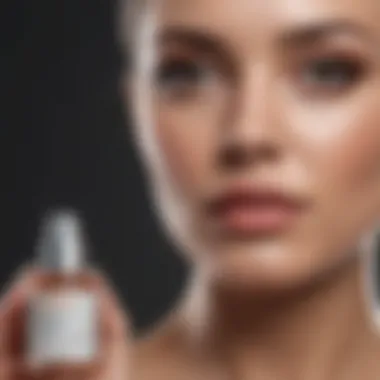Top Creams for Treating Hyperpigmentation & Dark Spots


Intro
Hyperpigmentation and dark spots are common skin concerns that many individuals encounter. Such skin conditions can arise from a variety of factors, including sun exposure, hormonal changes, and skin injuries. As a result, understanding the underlying mechanisms and effective treatments is crucial for anyone seeking to achieve a more even skin tone.
In this guide, we will explore the best creams available today that target hyperpigmentation and dark spots. We will delve into the active ingredients known for their efficacy, compare various product formulations, and provide insights on different skin types. Additionally, we will highlight the importance of a comprehensive skincare routine and preventative measures to maintain skin health.
With an ever-evolving market of skincare products, it is vital to stay informed about the latest trends and effective solutions. This article aims to arm you with the knowledge and resources needed to make informed decisions about your skincare choices.
Understanding Hyperpigmentation
Hyperpigmentation is a condition that affects many individuals, causing uneven skin tone and dark spots. It can be annoying and may influence the overall appearance of skin, which is why understanding it forms a critical part of skin care discussions. Knowing the different types, causes, and the impact of skin type on hyperpigmentation can guide individuals in selecting the right creams and treatments. This section aims to clarify these elements, providing a foundation for proactive management of hyperpigmentation.
Definition and Causes
Hyperpigmentation occurs when areas of skin become darker than the surrounding tissue. This is due to an excess production of melanin, the pigment responsible for skin color. Factors contributing to hyperpigmentation include; sun exposer, hormonal changes, and certain medications. Furthermore, skin injuries such as cuts or burns can trigger this condition, leading to discoloration during the healing process. Understanding the causes helps in tailoring treatment and preventive measures.
Types of Hyperpigmentation
Hyperpigmentation can manifest in several forms. Each type has unique characteristics and causes that are essential to address in a skincare routine.
Melasma
Melasma is especially common in pregnant women and those taking hormonal treatments. It is identified by brown or gray-brown patches, primarily on the face. This type of hyperpigmentation often results from hormonal fluctuations or sun exposure. The key characteristic of melasma is its recurrence; once it appears, it can be challenging to eliminate completely. This makes it a significant focus for creams aimed at reducing pigment irregularities.
Sun-induced Hyperpigmentation
Also known as solar lentigines or age spots, sun-induced hyperpigmentation is linked directly to UV radiation from the sun. These spots become more noticeable with age, as skin loses elasticity and becomes thinner. The characteristics of this condition include flat, round spots usually found on sun-exposed areas like the face, hands, and arms. Treating sun-induced hyperpigmentation can be effective with topical agents, making it a popular area for specialized creams.
Post-inflammatory Hyperpigmentation
Post-inflammatory hyperpigmentation occurs after an injury or inflammatory process, like acne or eczema. It leaves behind dark marks where skin has healed. This type is often a concern for individuals with darker skin tones, as the contrast can be more pronounced. The defining characteristic is that it generally resolves over time; however, treatment can hasten the process. This is why it is often a key target for creams developed for dark spots.
Skin Types and Hyperpigmentation
Different skin types respond differently to hyperpigmentation. Oily skin may be more prone to post-inflammatory hyperpigmentation due to acne, while dry skin can exhibit more melasma tendencies due to dehydration. Understanding one’s skin type is essential for choosing the right formulations. Tailoring treatments, and products based on skin type can improve efficacy and user experience.
Recognizing the nuances surrounding hyperpigmentation can provide individuals with a more informed approach to their skincare. It allows them to make better choices regarding products and treatment plans.
Key Ingredients for Treatment
Understanding the key ingredients in creams designed for hyperpigmentation and dark spots is crucial. This knowledge not only informs users about what to expect from a product but also helps in making an informed choice. Each ingredient has unique benefits and can interact differently with various skin types. Being aware of specific elements allows individuals to target their concerns effectively.
Vitamin
Vitamin C is widely recognized for its powerful role in skin health. This ingredient is a potent antioxidant that helps to neutralize free radicals, which can cause oxidative stress and lead to skin damage. In terms of hyperpigmentation, Vitamin C inhibits melanin production. This reduction can help in diminishing dark spots and even out skin tone over time. Many women appreciate this ingredient because it also adds brightness and radiance to the complexion.
When choosing a product with Vitamin C, it is essential to consider the formulation. Options like ascorbic acid are potent but may require careful usage to avoid irritation. Look for concentrations between 10%-20% for optimal results.
Hydroquinone


Hydroquinone is often considered the gold standard for treating dark spots. It works by inhibiting tyrosinase, the enzyme responsible for melanin production. This ingredient, approved for short-term use, can provide significant results, particularly for stubborn hyperpigmentation. However, it is important to approach hydroquinone with caution. Extended usage can lead to side effects such as skin irritation or a condition known as ochronosis, which causes bluish-black pigmentation. Typically, products contain between 2%-4% hydroquinone, and it is advisable to consult a dermatologist for guidance, especially for sensitive skin.
Retinoids
Retinoids, derivatives of Vitamin A, are highly regarded in skincare. They promote skin cell turnover, essentially bringing fresh skin to the surface and diminishing the appearance of dark spots. This mechanism can reduce the visibility of hyperpigmentation as new skin cells replace the old ones. Retinoids also boost collagen production, improving skin texture and elasticity.
When using retinoids, it is key to build up tolerance gradually. Starting with a lower concentration can minimize potential irritation. Common forms include retinol and tretinoin, with the latter being available via prescription. Users should also ensure they incorporate sun protection, as retinoids can increase skin sensitivity to sunlight.
Niacinamide
Niacinamide, or Vitamin B3, offers multiple benefits for the skin, making it a versatile ingredient. It helps to brighten and even out skin tone, particularly by reducing the appearance of dark spots. Additionally, niacinamide can strengthen the skin barrier, promoting hydration. It works by inhibiting the transfer of melanin to skin cells, thus contributing to a more uniform complexion.
One of the appealing factors of niacinamide is its low potential for irritation. It can be a suitable option for all skin types, including sensitive skin. Typically found in concentrations of 2% to 10%, niacinamide often works well in conjunction with other active ingredients, enhancing their effectiveness.
Ultimately, understanding these key ingredients plays a vital role in selecting the right cream for individual needs. Women seeking to address hyperpigmentation should consider not only the active components but also their skin type and personal sensitivities.
Choosing the right cream involves more than just picking a popular product. Researching ingredients helps to create a personalized approach, resulting in enhanced skincare outcomes.
Evaluating the Effectiveness of Creams
Understanding how to evaluate the effectiveness of creams for hyperpigmentation and dark spots is essential for anyone seeking clear skin. The evaluation process informs consumers about which products can deliver results and supports informed purchasing decisions. It encompasses not just product performance, but also safety and suitability.
Understanding Efficacy
Efficacy refers to the ability of a cream to produce the desired effect in reducing pigmentation. Various factors determine efficacy, including the concentration of active ingredients, formulation stability, and how well the cream penetrates the skin. A cream may contain promising ingredients, but if not present in optimal concentrations or if the formulation is poor, results may be limited.
- Ingredient Concentration: Certain compounds are effective only within a specific concentration range. For instance, Vitamin C shows better results at concentrations between 10% and 20%.
- Formulation Type: Ointments, creams, gels, and serums each offer different benefits and can impact how effectively ingredients are absorbed by the skin.
Clinical Studies and Research
Clinical research provides substantial evidence on the effectiveness of specific creams. Such studies often involve controlled environments and detailed methodologies, yielding data that product labels may not fully disclose.
- Randomized Trials: Many reputable products have undergone randomized clinical trials showing their efficacy in reducing dark spots.
- Longitudinal Studies: These studies assess the long-term benefits and any side effects of continuous cream usage, giving potential users insight into expected results.
- Peer-Reviewed Journals: Research published in journals adds credibility and should be consulted for anyone looking to understand how well a product performs.
"Clinical assessment and research data are vital in identifying reliable creams for treating hyperpigmentation."
Consumer Testimonials
Consumer feedback offers practical insight beyond clinical data. Testimonials can illustrate day-to-day experiences and outcomes that clinical settings might not express.
- Before and After Photos: Many users share visual evidence of their progress, giving potential buyers a clearer picture of what to expect.
- Personal Stories: Diverse experiences can help the audience understand how a product works across various skin types. Reviews reflecting on skin tone variations can guide users in making appropriate choices.
- Ratings and Recommendations: User ratings found on e-commerce platforms provide a quick reference to overall satisfaction levels among users.
Top Creams for Hyperpigmentation
Understanding the right creams for hyperpigmentation is crucial for effective skincare. Hyperpigmentation manifests as dark spots on the skin, often leading to insecurities and concerns about skin tone. The right formulation can address these issues, promote an even complexion, and restore confidence. When searching for a cream, it is essential to consider not only the ingredients but also the specific skin type and the individual needs of the user.
Choosing a depigmenting cream requires careful evaluation of benefits and possible side effects. Some products may work better for oily skin and others for dry or sensitive skin. Additionally, the cream's mode of application and the regularity may impact its effectiveness. Therefore, knowledge about the various categories of products available is vital for informed choices.
Acne-Free Depigmenting Creams


Acne scars often lead to post-inflammatory hyperpigmentation. For individuals with acne-prone skin, some creams are specially formulated to lighten hyperpigmentation while preventing breakouts. These products typically contain ingredients like salicylic acid or niacinamide, which can help combat both acne and discoloration.
When selecting acne-free creams, one must consider:
- Non-comedogenic formulas: These are designed not to clog pores.
- Active ingredients: Look for salicylic acid, glycolic acid, and niacinamide that act to enhance skin clarity.
- Hydrating elements: Creams should also contain moisturizers to prevent excessive dryness that can result from treatment.
Natural Formulations
More consumers are leaning towards natural creams for hyperpigmentation due to concerns about synthetic chemicals. Products using natural ingredients, such as licorice root extract and vitamin C, can offer gentler lightening effects. These formulations tend to have fewer side effects compared to stronger chemical alternatives.
Key benefits of natural formulations include:
- Gentleness on the skin: Reduced risk of irritation and adverse reactions.
- Soothing properties: Many natural ingredients have anti-inflammatory effects.
- Long-term skin health: The holistic focus on skin nourishment often leads to improved overall skin quality.
Prescription Options
For more stubborn cases of hyperpigmentation, prescription creams can be the most effective solution. These products usually have higher concentrations of active ingredients, such as hydroquinone or retinoids. Hydroquinone is well-known for its strong skin-lightening properties and is often prescribed in various strengths depending on the severity of the condition.
When considering prescription options, individuals should note:
- Potential side effects: Ingredients like hydroquinone can cause sensitivity, so it's imperative to use it as directed.
- Doctor supervision: These treatments should be monitored by a dermatologist to avoid complications.
- Effectiveness timelines: Results may take longer than over-the-counter options but can lead to significant improvements in skin tone.
Prescription creams are not just more potent; they also target deeper skin layers, offering solutions not possible with over-the-counter products.
Choosing the right cream involves understanding these categories and aligning them with personal skin needs. A suitable product can enhance clarity and confidence in a person's skin.
Holistic Skin Care Routines
Holistic skin care routines are essential for managing hyperpigmentation and dark spots effectively. A holistic approach considers the overall health of the skin, integrating both topical treatments and lifestyle choices. This elicits a beneficial effect, not just on skin appearance but also on overall well-being. Maintenance of a consistent skin care routine can greatly enhance the effectiveness of the creams used for treating hyperpigmentation.
Daily Use Practices
Morning Routine
The morning routine serves as the foundation for a successful day of skin care. A key characteristic of this routine is its focus on protection. Applying a broad-spectrum sunscreen with at least SPF 30 is vital, as it shields the skin from harmful UV rays that can worsen dark spots. Additionally, incorporating a vitamin C serum can provide antioxidant protection and assist in brightening the skin. This practice is popular because it not only helps in preventing further pigmentation but also improves skin tone over time. However, it’s essential to choose products that suit your skin type to avoid irritation.
Evening Routine
The evening routine is crucial for repair and regeneration. During this time, the skin undergoes natural healing processes. Using products with retinoids or alpha hydroxy acids can promote cell turnover and fade dark spots effectively. This routine emphasizes the importance of moisturizing, as well-hydrated skin can recover better overnight. The unique feature of evening routines is the use of active ingredients that might be too harsh for daytime use. While this approach can be highly effective, it’s critical to introduce these ingredients gradually to prevent sensitivity and irritation.
Avoiding Triggers
Avoiding triggers plays a significant role in the management of hyperpigmentation. Common triggers include excessive sun exposure, hormonal fluctuations, and certain medications. To mitigate these, individuals can wear protective clothing and limit sun exposure, especially during peak hours. Additionally, keeping track of any skincare products or treatments that may cause adverse reactions can help in avoiding unnecessary flare-ups of hyperpigmentation. By identifying and avoiding these triggers, one can substantially enhance the efficacy of the creams used for treatment, leading to better skin outcomes.
"A comprehensive approach to skin care beyond creams can significantly impact the results of treating dark spots."
Incorporating holistic practices into one’s daily regimen can create a more sustainable and long-lasting impact on managing hyperpigmentation.
Preventative Measures


Preventing hyperpigmentation and dark spots is crucial for maintaining an even skin tone. Awareness of potential triggers and adapting daily habits can significantly reduce the risk of skin discoloration. This section explores essential elements and benefits of preventative measures while considering practical steps for long-lasting results.
Sunscreen Importance
Sunscreen is the first line of defense against hyperpigmentation. It shields the skin from ultraviolet (UV) radiation, which can worsen existing dark spots and create new ones. Regularly applying a broad-spectrum sunscreen with an SPF of at least 30 is recommended for daily use, regardless of the weather or season. This not only protects against sunburn but also helps prevent photoaging, which is a contributing factor to uneven skin tone.
- Suncscreen should be applied 30 minutes before sun exposure and reapplied every two hours, or more frequently if sweating or swimming.
- Look for products that contain zinc oxide or titanium dioxide, as these physical blockers offer effective protection.
"Sunscreen is essential. Regular application can drastically reduce the risk of dark spots associated with sun exposure."
In addition to using sunscreen, wearing protective clothing and seeking shade during peak sun hours can complement sun protection efforts. A consistent sunscre application is one of the simplest yet most powerful strategies in the fight against hyperpigmentation.
Diet and Lifestyle Factors
Diet and lifestyle choices significantly influence skin health and pigmentation. A balanced diet rich in antioxidants can support the skin in its natural repair processes. Foods high in vitamins C and E, such as oranges, spinach, and nuts, can help combat oxidative stress, a factor possible leading to hyperpigmentation.
- Hydration: Drinking adequate water keeps the skin hydrated and supports detoxification processes.
- Limiting sugar and processed foods: High sugar intake can lead to inflammation. Inflammation can promote dark spots and sensitivity.
- Regular exercise: Promotes circulation and can foster healthiness from within.
Furthermore, avoiding smoking and excessive alcohol is essential, as these habits can damage the skin's appearance and function. Stress management also plays a vital role in maintaining skin health. Chronic stress can exacerbate conditions like melasma and post-inflammatory hyperpigmentation.
Consulting Professionals
Consulting a professional can significantly impact the management of hyperpigmentation and dark spots. Dermatologists and skincare specialists possess the required knowledge and skills to assess individual skin types, conditions, and specific needs. They can provide personalized recommendations that are more fitting than over-the-counter products. Understanding when to seek help is vital in achieving desired results.
When to Seek Help
It is essential to recognize signs that might require professional input. If dark spots or hyperpigmentation worsen despite using topical treatments, seeking a dermatologist's guidance is advisable. Additionally, if there are sudden changes in skin pigmentation, such as rapid darkening or new spots appearing, it warrants a consultation. Patients with underlying skin conditions may also benefit from professional assessments. Early intervention can lead to better outcomes.
Cosmetic Treatment Options
Various cosmetic treatments are available for addressing hyperpigmentation effectively. Two common options are chemical peels and laser treatments, which offer unique benefits.
Chemical Peels
Chemical peels involve applying a chemical solution to exfoliate the skin. This process promotes cell turnover, helping to reduce the appearance of dark spots over time. A key characteristic of chemical peels is their ability to penetrate deeper layers of the skin. This can result in improved skin texture and tone. They are considered a beneficial choice due to their effectiveness in treating various types of hyperpigmentation. However, it is important to note that chemical peels may cause skin irritation or sensitivity post-treatment. Proper aftercare is crucial for best results.
Laser Treatments
Laser treatments utilize focused light technology to target hyperpigmentation. This method breaks down melanin in the skin, leading to a clearer complexion. A significant advantage of laser treatments is their precision; they can treat specific areas without affecting surrounding skin. Due to their efficiency, many find lasers popular for reducing stubborn dark spots. However, considerations include cost and the need for multiple sessions to achieve optimal results. Additionally, some individuals might experience redness or swelling after the procedure.
Consulting with a professional can provide tailored advice and access to advanced treatments, promoting positive skin health outcomes.
End
In summary, understanding hyperpigmentation and the available treatments is essential for anyone looking to enhance their skin's appearance. This article has traversed various aspects, from defining hyperpigmentation to exploring effective creams and holistic skin care practices.
Key Takeaways
- Understanding Hyperpigmentation: It is crucial to recognize the factors contributing to dark spots, including sun exposure and hormonal changes. By identifying these triggers, individuals can make informed decisions about treatments.
- Active Ingredients Matter: Key ingredients like Vitamin C, Hydroquinone, and Niacinamide have visible effects on reducing dark spots.
- Consistency is Key: Regular use of appropriate creams is vital. Adhering to usage guidelines can lead to improved results over time.
- Integrated Approach: Besides treatments, a holistic approach combining sun protection, diet, and lifestyle changes yields better results.
Future Considerations in Treatment
The landscape of skincare is ever-evolving, and future treatments for hyperpigmentation may incorporate new active ingredients or advanced technologies. Continued research into the genetic factors of skin conditions could lead to personalized skincare solutions. Furthermore, cosmetic procedures, like laser treatments and chemical peels, may become more refined and accessible, offering quicker results for those with stubborn pigmentation issues.
Ultimately, as science advances, so too will the understanding of skin health, leading to more effective strategies for managing hyperpigmentation. Staying informed about innovations will empower individuals in making the best choices for their skin.



